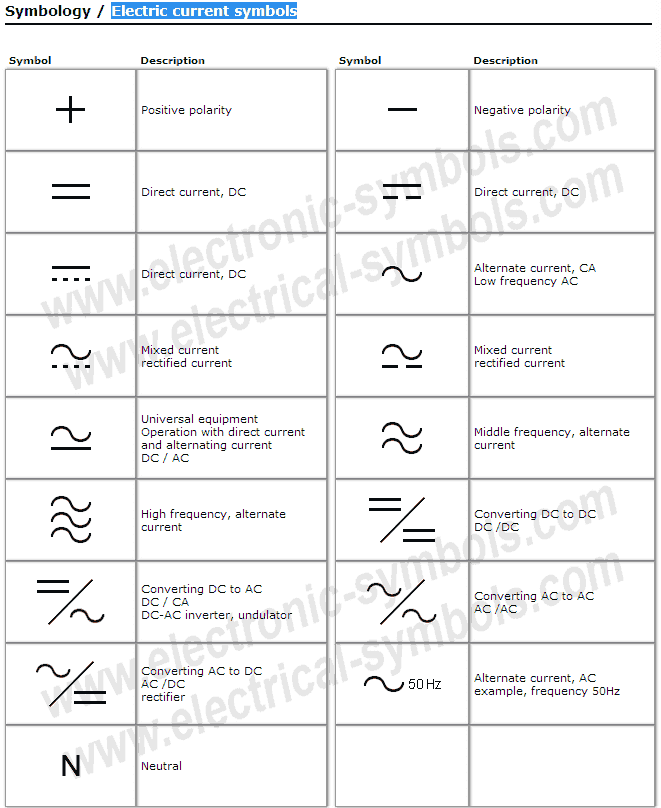Understanding AC and DC Current Symbols
Have you ever wondered about the squiggly line and the dashed line you often see on electrical devices or in diagrams? These are the symbols representing alternating current (AC) and direct current (DC), respectively. Understanding these fundamental representations is crucial for anyone working with electronics, from seasoned engineers to curious hobbyists.
The symbols for AC and DC current aren't just arbitrary marks; they are essential for clear communication in the world of electronics. They convey the type of current flowing in a circuit, aiding in design, troubleshooting, and safe operation. This article dives into the history, meaning, and practical applications of these symbols.
The need for distinct AC and DC symbols arose with the development of both current types. Initially, direct current, produced by batteries, was the primary power source. However, the advent of alternating current, with its advantages in power transmission, necessitated a clear way to differentiate the two on circuit diagrams. The symbols emerged as a concise and universally recognized method.
These visual representations are more than just convenient shorthand; they are the language of electrical engineering. Imagine trying to read a map without understanding the symbols for roads, rivers, or mountains. Similarly, AC and DC symbols provide essential information for interpreting circuit diagrams and understanding the flow of electrical energy.
Misinterpreting or ignoring these symbols can lead to serious consequences, from building faulty circuits to potentially dangerous electrical mishaps. Therefore, a solid grasp of these symbols is paramount for anyone involved in electrical work.
The AC symbol, a sinusoidal wave (~), visually represents the alternating nature of the current's flow, where the direction of electron movement periodically reverses. The DC symbol, a straight line with a dashed line below it (=), depicts the constant, unidirectional flow of direct current.
These symbols' importance lies in their ability to quickly and accurately convey critical information about the electrical system. They streamline communication between engineers, technicians, and even consumers, ensuring everyone is on the same page regarding the type of current involved.
One of the key benefits of using standard symbols is enhanced safety. By clearly indicating the type of current present, the symbols help prevent accidents caused by incorrect wiring or component selection. For example, connecting a DC device to an AC power source could damage the device or even create a fire hazard.
Another benefit is simplified circuit analysis. Using these symbols, engineers can easily understand the flow of current within complex circuits, facilitating troubleshooting and design optimization. This contributes to more efficient and reliable electronic systems.
Finally, using standardized symbols promotes global understanding. Regardless of language barriers, engineers and technicians worldwide can interpret electrical diagrams and schematics with ease, fostering collaboration and innovation in the field of electronics.
Some best practices for using AC/DC current symbols include consistently using the correct symbol, ensuring proper placement within the circuit diagram, and clearly labeling the symbols when necessary, particularly in complex circuits.
Advantages and Disadvantages of Standardized Symbols
While the advantages are numerous, it's worth acknowledging that challenges exist in ensuring consistent usage and interpretation, particularly across different industries or with evolving standards. Education and clear documentation are essential to address these challenges.
Frequently Asked Questions:
1. What does the AC symbol represent? It represents the alternating flow of current.
2. What does the DC symbol represent? It represents the direct, unidirectional flow of current.
3. Why are these symbols important? They are essential for clear communication in electrical engineering.
4. What can happen if these symbols are misused? It can lead to circuit malfunctions and safety hazards.
5. Where can I find more information about electrical symbols? Various online resources and textbooks provide detailed information.
6. How do I learn to interpret circuit diagrams using these symbols? Electrical engineering courses and online tutorials offer comprehensive instruction.
7. Are there different variations of these symbols? While the basic symbols remain consistent, minor variations might exist in specific applications.
8. How can I contribute to standardizing these symbols? Following established standards and promoting best practices within your field contributes to overall consistency.
In conclusion, understanding and correctly using the symbols for AC and DC current is fundamental to working with electrical systems. These symbols are the bedrock of clear communication in the field, enabling safe and efficient design, analysis, and operation of electrical circuits. Mastering these simple yet powerful symbols empowers individuals to engage effectively with the world of electronics, from basic circuits to complex power grids. Continue learning and exploring the fascinating world of electricity, and always prioritize safety and accurate symbol usage. This will ensure not only your understanding but also contribute to a safer and more efficient electrical landscape for everyone.
Navigating loss with grace ocker funeral home in fort smith
Happy weekend images boosting your online presence
Crickets fastest bowlers explored speed demons of the pitch

Schematic Symbol For Dc Power Supply | Innovate Stamford Now

Learn the meaning function and usage of multimeter symbols with this | Innovate Stamford Now

How to Use a Multimeter to Measure Voltage Current and Resistance | Innovate Stamford Now

Voltage Symbols Ac Dc | Innovate Stamford Now

Símbolos Electrónicos Electric current symbols | Innovate Stamford Now

Actron Cp7672 Features Chart Digital Multimeter Revised 55 OFF | Innovate Stamford Now

symbols of ac and dc current | Innovate Stamford Now

What is a multimeter used for | Innovate Stamford Now

Dc Power Supply clip art 103515 Free SVG Download 4 Vector | Innovate Stamford Now

Physics Circuit Diagram Symbols | Innovate Stamford Now

Ac Dc Power Supply Symbol | Innovate Stamford Now

Dc Power Source Schematic Symbol | Innovate Stamford Now

Inductance Symbol On Multimeter | Innovate Stamford Now

symbols of ac and dc current | Innovate Stamford Now
symbols of ac and dc current | Innovate Stamford Now